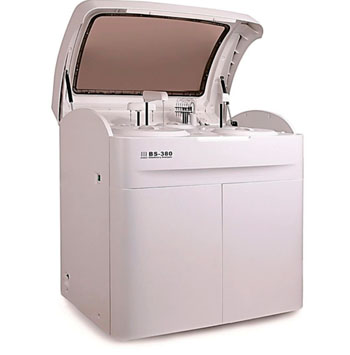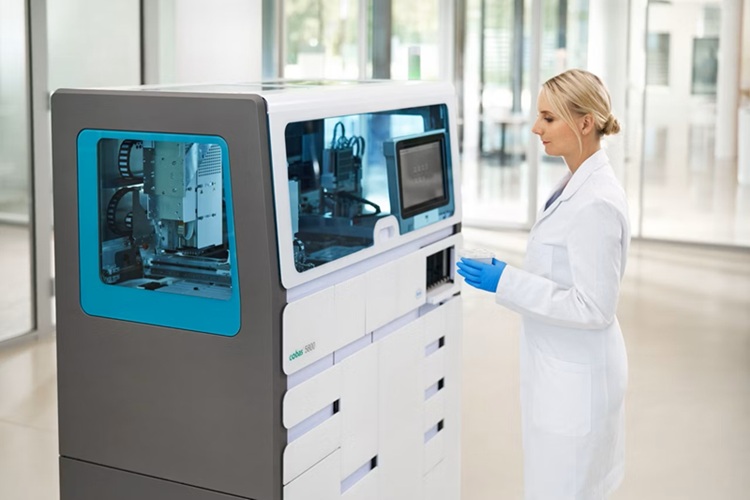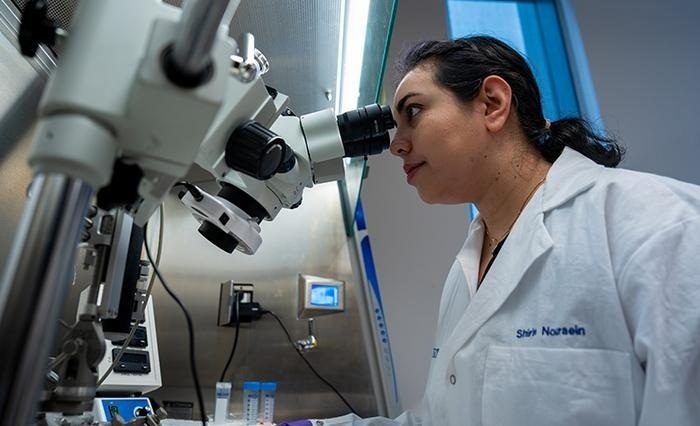Novel Turbidimetric Immunoassay Evaluated for Fecal Calprotectin
|
By LabMedica International staff writers Posted on 28 Sep 2016 |

Image: The BS-380 automatic biochemistry analyzer (Photo courtesy of Mindray).
Calprotectin is a multifunctional protein that plays an important role in the diagnosis and follow-up of inflammatory bowel disease and high levels of calprotectin in stool samples are associated with inflammation of the intestinal tract.
Fecal calprotectin assays are widely used to exclude inflammatory bowel disease (IBD) in patients with suspected IBD, but the problem with most of the fecal calprotectin assays is the rather long test-turnaround times, before the results are available to the physician.
Scientists at Uppsala University (Sweden) optimized a particle enhanced turbidimetric immunoassay (PETIA) for fecal calprotectin and validated the assay for two clinical autoanalyzers using routine fecal samples. They compared the PETIA with a commercial enzyme-linked immunosorbent assay (ELISA), known as the Bühlmann fCAL ELISA (Bühlmann Laboratories, Schönenbuch, Switzerland). This new latex based turbidimetric calprotectin assay applies particles coated with anti-human calprotectin (MRP8/14) antibodies: the agglutination is proportional to the calprotectin concentration.
The fecal calprotectin PETIA was validated on two chemistry analyzers, the Mindray BS-380 (Mindray, Shenzhen, China) and the Cobas 501 (Roche Diagnostics, Basel, Switzerland). The assay is linear in the range 11 μg/g to 2,000 μg/g, with a limit of quantitation of approximately 10 μg/g. No antigen excess hook effect was observed up to 10,000 μg/g to 15,000 μg/g depending on the instrument used. The turbidimetric method showed a good agreement with the Bühlmann ELISA. The total coefficient of variation was 3% to 8% in the 50 μg/g to100 μg/g range.
The authors concluded that the fecal calprotectin PETIA, fCal Turbo, is well suited for rapid analysis of fecal calprotectin on Mindray BS-380 or Cobas 501 clinical chemistry analyzers. The test results are concordant with the Bühlmann fecal MRP8/14 ELISA. The study was published in the September 2016 issue of the Journal of Clinical Laboratory Analysis.
Related Links:
Uppsala University
Bühlmann Laboratories
Mindray
Roche Diagnostics
Fecal calprotectin assays are widely used to exclude inflammatory bowel disease (IBD) in patients with suspected IBD, but the problem with most of the fecal calprotectin assays is the rather long test-turnaround times, before the results are available to the physician.
Scientists at Uppsala University (Sweden) optimized a particle enhanced turbidimetric immunoassay (PETIA) for fecal calprotectin and validated the assay for two clinical autoanalyzers using routine fecal samples. They compared the PETIA with a commercial enzyme-linked immunosorbent assay (ELISA), known as the Bühlmann fCAL ELISA (Bühlmann Laboratories, Schönenbuch, Switzerland). This new latex based turbidimetric calprotectin assay applies particles coated with anti-human calprotectin (MRP8/14) antibodies: the agglutination is proportional to the calprotectin concentration.
The fecal calprotectin PETIA was validated on two chemistry analyzers, the Mindray BS-380 (Mindray, Shenzhen, China) and the Cobas 501 (Roche Diagnostics, Basel, Switzerland). The assay is linear in the range 11 μg/g to 2,000 μg/g, with a limit of quantitation of approximately 10 μg/g. No antigen excess hook effect was observed up to 10,000 μg/g to 15,000 μg/g depending on the instrument used. The turbidimetric method showed a good agreement with the Bühlmann ELISA. The total coefficient of variation was 3% to 8% in the 50 μg/g to100 μg/g range.
The authors concluded that the fecal calprotectin PETIA, fCal Turbo, is well suited for rapid analysis of fecal calprotectin on Mindray BS-380 or Cobas 501 clinical chemistry analyzers. The test results are concordant with the Bühlmann fecal MRP8/14 ELISA. The study was published in the September 2016 issue of the Journal of Clinical Laboratory Analysis.
Related Links:
Uppsala University
Bühlmann Laboratories
Mindray
Roche Diagnostics
Latest Clinical Chem. News
- Chemical Imaging Probe Could Track and Treat Prostate Cancer
- Mismatch Between Two Common Kidney Function Tests Indicates Serious Health Problems
- VOCs Show Promise for Early Multi-Cancer Detection
- Portable Raman Spectroscopy Offers Cost-Effective Kidney Disease Diagnosis at POC
- Gold Nanoparticles to Improve Accuracy of Ovarian Cancer Diagnosis
- Simultaneous Cell Isolation Technology Improves Cancer Diagnostic Accuracy
- Simple Non-Invasive Hair-Based Test Could Speed ALS Diagnosis
- Paper Strip Saliva Test Detects Elevated Uric Acid Levels Without Blood Draws
- Prostate Cancer Markers Based on Chemical Make-Up of Calcifications to Speed Up Detection
- Breath Test Could Help Detect Blood Cancers
- ML-Powered Gas Sensors to Detect Pathogens and AMR at POC
- Saliva-Based Cancer Detection Technology Eliminates Need for Complex Sample Preparation
- Skin Swabs Could Detect Parkinson’s Years Before Symptoms Appear
- New Clinical Chemistry Analyzer Designed to Meet Growing Demands of Modern Labs

- New Reference Measurement Procedure Standardizes Nucleic Acid Amplification Test Results
- Pen-Like Tool Quickly and Non-Invasively Detects Opioids from Skin
Channels
Clinical Chemistry
view channel
Chemical Imaging Probe Could Track and Treat Prostate Cancer
Prostate cancer remains a leading cause of illness and death among men, with many patients eventually developing resistance to standard hormone-blocking therapies. These drugs often lose effectiveness... Read more
Mismatch Between Two Common Kidney Function Tests Indicates Serious Health Problems
Creatinine has long been the standard for measuring kidney filtration, while cystatin C — a protein produced by all human cells — has been recommended as a complementary marker because it is influenced... Read moreMolecular Diagnostics
view channel
Four-Gene Blood Test Rules Out Bacterial Lung Infection
Lower respiratory tract infections (LRTIs) are among the most common reasons for antibiotic prescriptions, yet distinguishing bacterial infections from viral ones remains notoriously difficult.... Read more
New PCR Test Improves Diagnostic Accuracy of Bacterial Vaginosis and Candida Vaginitis
Bacterial vaginosis (BV) impacts approximately 25% of women of reproductive age, while up to 75% of women experience candida vaginitis (CV) at least once in their lifetime. Vaginal symptoms are one of... Read moreHematology
view channel
Platelet Activity Blood Test in Middle Age Could Identify Early Alzheimer’s Risk
Early detection of Alzheimer’s disease remains one of the biggest unmet needs in neurology, particularly because the biological changes underlying the disorder begin decades before memory symptoms appear.... Read more
Microvesicles Measurement Could Detect Vascular Injury in Sickle Cell Disease Patients
Assessing disease severity in sickle cell disease (SCD) remains challenging, especially when trying to predict hemolysis, vascular injury, and risk of complications such as vaso-occlusive crises.... Read more
ADLM’s New Coagulation Testing Guidance to Improve Care for Patients on Blood Thinners
Direct oral anticoagulants (DOACs) are one of the most common types of blood thinners. Patients take them to prevent a host of complications that could arise from blood clotting, including stroke, deep... Read moreMicrobiology
view channelRapid POC Tuberculosis Test Provides Results Within 15 Minutes
Tuberculosis remains one of the world’s deadliest infectious diseases, and reducing new cases depends on identifying individuals with latent infection before it progresses. Current diagnostic tools often... Read more
Rapid Assay Identifies Bloodstream Infection Pathogens Directly from Patient Samples
Bloodstream infections in sepsis progress quickly and demand rapid, precise diagnosis. Current blood-culture methods often take one to five days to identify the pathogen, leaving clinicians to treat blindly... Read morePathology
view channelAI Tool Outperforms Doctors in Spotting Blood Cell Abnormalities
Diagnosing blood disorders depends on recognizing subtle abnormalities in cell size, shape, and structure, yet this process is slow, subjective, and requires years of expert training. Even specialists... Read more
AI Tool Rapidly Analyzes Complex Cancer Images for Personalized Treatment
Complex digital biopsy images that typically take an expert pathologist up to 20 minutes to assess can now be analyzed in about one minute using a new artificial intelligence (AI) tool. The technology... Read moreTechnology
view channel
AI Saliva Sensor Enables Early Detection of Head and Neck Cancer
Early detection of head and neck cancer remains difficult because the disease produces few or no symptoms in its earliest stages, and lesions often lie deep within the head or neck, where biopsy or endoscopy... Read more
AI-Powered Biosensor Technology to Enable Breath Test for Lung Cancer Detection
Detecting lung cancer early remains one of the biggest challenges in oncology, largely because current tools are invasive, expensive, or unable to identify the disease in its earliest phases.... Read moreIndustry
view channel
Abbott Acquires Cancer-Screening Company Exact Sciences
Abbott (Abbott Park, IL, USA) has entered into a definitive agreement to acquire Exact Sciences (Madison, WI, USA), enabling it to enter and lead in fast-growing cancer diagnostics segments.... Read more
























